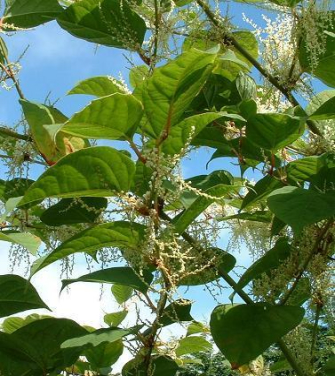Japanese knotweed
Japanese Knotweed is in-fact considered a weed. Since the introduction here in the 19th century for rich people's entertainment they have colonized almost every riverbank, road verge, and Rastafarian's house in the country. No longer can one go for a nice walk in any of these locations without tripping over the carelessly strewn limbs of these weeds, (the knots are often undone while at rest). Speaking only Japanese, they impact heavily on local biodiversity.
Despite efforts to trick local stoners into cleaning up the excessive foliage the weed continues to spread like, um... Japanese Knotweed.
Tragic History[edit | edit source]
Why is the Japanese knotweed so prone to clog our river banks, grow too wildly, and extend its leafy branches into our pockets to drag away our credit cards?
This knotweed wasn't always so hateful. A thousand years ago, somewhere on Honshu in the little valley Pichikinu, the Japanese knotweed lived a happy life, much loved by its parents, the Japanese ropeweed and the Japanese handweed. But this happiness was cut short when an evil Shogun ordered the extermination of the ropeweed and handweed to make room for endless tracts of cherry trees!
Just as the Shogun was about to order the extermination of the knotweed as well, the plucky vegetation allowed itself to wither and let the river carry its seeds to safety of the Caves of Darkness! There, the little sprouts of the seeds plotted their revenge, not only against the evil Shogun, but against all humanity!
Soon the weed filled the caves with its endless vines and branches and spread out across the forests and waterways! It strangled the carp that brought so much joy to little children and grown-ups alike. It choked the life out of flowery gardens as the gardeners looked on and screamed themselves to death out of sheer horror! Teenagers started sporting hairstyles that resembled the foul weed, and had to be beheaded for disturbing the harmony of their households and villages!
If only we could say that the knotweed finally got counseling, and realized that it shouldn't blame all humanity for the act of one evil Shogun! Alas, this never happened, and the tragic history of the Japanese knotweed continues to this day!
Facts[edit | edit source]
The Japanese Knotweed was first identified by Japan's indigenous people, the Ainu, whose term for the plant translates literally as "You thought this was salad? You idiot!" Later, as newcomers to Japan rose to power, Japanese peasants noticed the resemblance between the knotweed and multinational corporations, whose pestiferous branches overran everything. So prevalent did this plant become that Japanese herbalists became bored with it and refused to study it further. Yumi Hotodogu, the greatest of the early Japanese herbalists, is reputed to have said "Japanese knotweed! By all the kami, I am sick of it! I shall study the lotus instead!"
It was not until centuries after the First Japanese Reformation, which replaced the ancient practice of writing on eggs with the use of paper, that knotweed became respectable once more. First, seamen used it to practice tying knots. Soon, the knotweed was used to tie knots around the base of the male member, thereby enhancing its rigidity. Once this practice became common, the Ancient Japanese League of Mild Masochists began using clumps of the knotweed as flogging devices during the Dodo Shogunate. With the social upheaval of the war between the Dodo and Ichi clans came a new use for the knotweed, namely sexual bondage.
During the Mojo Restoration of the 1960's, Japanese knotweed was celebrated for its alleged intoxicating properties. However, the celebration quickly ended when the League of Japanese Potheads, whose members take vows of perpetual intoxication, smoked the weed without falling down. This violated one of their Great Principles, namely that floors exist to be fallen upon rather than traversed. Though rumors of the plant's intoxicating properties persist in remote villages, "Japanese Knotweed" is NOT weed. Hence the name.
Types of Japanese Knotweed[edit | edit source]
Known subspecies include...
- Japanese Granny knotweed: Bakers claim that its comforting gray fuzz inspires them to bake the yummiest cookies for lots of little children!
- Japanese Gordian knotweed: Forms clumps and clots that can't be untangled.
- Japanese Sailor's knotweed: Used in the 1800's to bind the privy parts of sailors and so curb their lust!
- Japanese Sheepshank knotweed: Used to tie up incarcerated sheep so that the sheep won't shank each other.
